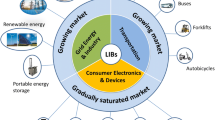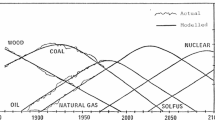Abstract
The nonlinear steady state behaviour of solid oxide fuel cells (SOFCs) is investigated. It is found that the temperature dependence of the electrolyte conductivity has a very strong influence on the occurrence of multiple steady states, instabilities and the formation of hot spots. Two correlations from the literature for the electrolyte conductivity are studied in a lumped model and in a 1D spatially distributed model of a SOFC. The cases of galvanostatic operation, potentiostatic operation, and operation under a constant ohmic load are considered. The lumped model possesses a unique steady state under galvanostatic operation and up to three steady states under potentiostatic operation or under constant load. In the distributed model, three steady states may coexist under galvanostatic operation and up to five under potentiostatic operation.
Similar content being viewed by others
Abbreviations
- B :
-
width of cell (m)
- c P :
-
molar heat capacity (J mol−1 K−1)
- C SE :
-
coefficient in Equation (24) (Ω−1 m−1)
- c t :
-
total gas concentration (mol m−3)
- d :
-
thickness of electrodes (m)
- D eff :
-
diffusion coefficient (m2 s−1)
- E :
-
activation energy (J mol−1)
- E SE :
-
coefficient in Equation (24) (J mol−1)
- F :
-
Faraday constant (96485 C mol−1)
- Δ R G :
-
free enthalpy of reaction at T ref (J mol−1)
- H :
-
height of gas channels (m)
- Δ R H :
-
heat of reaction (J mol−1)
- i :
-
current density (A m−2)
- I :
-
total cell current (A)
- \(\dot{n}\) :
-
molar flow (mol s−1)
- p :
-
pressure (Pa)
- R:
-
ohmic resistance (Ω)
- \({\mathbb R}\) :
-
gas constant (8.314 J mol−1 K−1)
- Δ R S :
-
entropy of reaction at T ref (J mol−1 K−1)
- t :
-
time (s)
- U Cell :
-
cell voltage (V)
- y j :
-
molar fraction
- z :
-
space coordinate (m)
- α:
-
heat transfer coefficient (W m−2 K−1)
- β1/2 :
-
coefficients in Equation (23)
- γ:
-
pre-exponential kinetic factor (A m−2)
- η:
-
overpotential (V)
- θ:
-
charge transfer coefficient
- λ:
-
heat conductivity of the solid (W m−1 K−1)
- ν:
-
stoichiometric coefficient
- ρ:
-
resistivity (Ω m)
- ρS :
-
density of the solid (kg m−3)
- Φ:
-
electrical potential (V)
- A:
-
anode
- C:
-
cathode
- E:
-
electrolyte
- S:
-
solid
References
Hudson J., Tsotsis T. (1994). Chemical Engineering Science 49:1493
Pismen L. (1980). Chemical Engineering Science 35:1950
Koper M., Sluyters J. (1994). Journal of Electroanalytical Chemistry 371:149
Krischer K., Mazouz N., Flätgen G. (2000). Journal of Physical Chemistry B 104:7545
Mazouz N., Krischer K. (2000). Journal of Physical Chemistry B 104:6081
Purwins H.-G., Radehaus C., Dirksmeyer T., Dohmen R., Schmeling R., Willebrand H. (1987). Physics Letters A 125:92
Hüpper G., E. Schöll G., Reggiani L. (1989). Solid-State Electronics 32:1787
Niedernostheide F.-J. ed. (1995). ‘Nonlinear Dynamics and Pattern Formation in Semiconductors and Devices’. Springer, Berlin
Koper M., Schmidt T., Marković N., Ross P. (2001). Journal of Physical Chemistry B 105:8381
10. Varela H., Krischer K. (2001). Catalysis Today 70:411
Lee J., Eickes C., Eiswirth M., Ertl G. (2002). Electrochimica Acta 47:2297
Zhang J., Datta R. (2004). Electrochemical and Solid State Letters 7:A37
Zhang J., Fehribach J., Datta R. (2004). Journal of the Electrochemical Society 151:A689
Benziger J., Chia E., Karnas E., Moxley J., Teuscher C., Kevrekidis I. (2004). AIChE Journal 50:1889
Chia E., Benziger J., Kevrekidis I. (2004). AIChE Journal 50:2320
Moxley J., Tulyani S., Benziger J. (2003). Chemical Engineering Science 58:4705
Mangold M., Krasnyk M., Sundmacher K. (2004). Chemical Engineering Science 59:4869
Costamagna P., Honegger K., (1998). Journal of the Electrochemical Society 145:3995
B. Munder, Y. Ye, L. Rihko-Struckmann and K. Sundmacher: Submitted to Catalysis Today (2005)
Liljenroth F. (1918). Chemical and Metallurgical Engineering 19:287
van Heerden C. (1958). Chemical Engineering Science 7:133
Mangold M., Kienle A., Mohl K., Gilles E. (2000). Chemical Engineering Science 55:441
Kolios G., Frauhammer J., Eigenberger G. (2000). Chemical Engineering Science 55:5945
Luss D. (1997). Industrial & Engineering Chemistry Research 36:2931
Acknowledgements
The authors thank Dipl.-Ing. (FH) Richard Hanke and Dipl.-Ing. Barbara Munder for helpful discussions.
Author information
Authors and Affiliations
Corresponding author
Additional information
Paper originally given at the CHISA Congress, Prague, August 2004.
Appendices
Appendix A. Model equations of the spatially distributed model
-
Anode and cathode gas channels:
-
Component material balances:
$$ {\partial\over \partial t}\left(y_j^{A/C} c_t^{A/C}\right)= \mp{1\over H^{A/C} B}{\partial\dot{n}_j^{A/C}\over \partial z}+{\nu_j^{A/C}\over H^{A/C}}{i\over 2F} $$(6)$$y_j^A(0,t)=y_{j,in}^A(t),\quad y_j^C(L,t) = y_{j,in}^C(t) $$(7)(j=H2, H2O on anode side, and j=N2, O2 on cathode side)
-
Total material balance:
$$ {\partial c_t^{A/C}\over \partial t}=\mp{1\over H^{A/C}B}{ \partial\dot{n}^{A/C}\over {\partial z}}+{1\over H^{A/C}} \sum_{j}\nu_j^{A/C}{i\over 2F} $$(8)$$ \dot{n}^A(0,t)=\dot{n}_{in}^A(t),\quad\dot{n}^C(L,t)=\dot{n}_{in}^C(t) $$(9) -
Temperature equation on anode side
$$ \eqalign{c_t^A c_P^A {\partial T^A\over \partial t}=&-{\dot{n}^A\over H^A B}c_P^A {\partial T^A\over \partial z}+{i\over 2F} {c_{P,{\rm H_2O}}\over H^A}\left( T^S - T^A \right)\cr &+{\alpha\over H^A}\left(T^S-T^A\right)} $$(10)$$ T^A(0,t)=T_{in}^A(t) $$(11) -
Temperature equation on cathode side
$$ c_t^C c_P^C {\partial T^C\over \partial t}={\dot{n}^C\over H^C B} c_P^C {\partial T^C\over \partial z}+{\alpha\over H^C} \left(T^S-T^C\right) $$(12)$$ T^C(L,t)=T_{in}^C(t) $$(13) -
Specific molar heat capacity:
$$ c_P^{A/C}=\sum_{j}y_j^{A/C} c_{P,j} $$(14) -
Thermal equation of state:
$$ c_t^{A/C}={p\over \mathbb{R} T^{A/C}} $$(15)
-
-
Solid phase:
-
- Component material balances:
$$ 0=D_{eff}^{A/C} c_t {y_j^{A/C}-y_j^S\over d^{A/C}}+\nu_j^{A/C}{i\over 2F} $$(16) -
Anodic reaction kinetics:
$$ i=\gamma^A y_{{\rm H}_2}^S y_{{\rm H_2O}}^S \hbox{exp}\left(- {E^A\over \mathbb{R} T^S}\right) \left\{\hbox{exp}\left(\theta_a^A{F\over \mathbb{R} T^S}\eta^A \right)-\hbox{exp}\left( -\theta_c^A{F\over \mathbb{R} T^S}\eta^A \right) \right\} $$(17) -
Cathodic reaction kinetics:
$$ i=\gamma^C {y_{{\rm O}_2}^S}^{0.25}\hbox{ exp}\left(- {E^C\over \mathbb{R}T^S}\right) \left\{\hbox{exp}\left( \theta_a^C{F\over \mathbb{R} T^S}\eta^C \right)-\hbox{exp}\left( -\theta_c^C{F\over \mathbb{R}T^S}\eta^C \right)\right\} $$(18) -
Charge balances in the electrodes:
$$ {\partial\over \partial z}\left({d^{A/C}\over \rho^{A/C}}{\partial \Phi^{A/C} \over \partial z}\right)=\pm i $$(19)$$ \Phi^A(0,t)=0, \quad {Bd^C\over \rho^C}\left.{\partial\Phi^C\over \partial z}\right|_{0,t}=I, \quad \left.{\partial\Phi^A\over \partial z}\right|_{L,t}= \left.{\partial\Phi^C\over \partial z}\right|_{L,t}=0 $$(20) -
Voltage drop in the electrolyte:
$$ \eqalign{ U^{\rm Cell}&=\Phi^C(0,t)-\Phi^A(0,t)\cr &=U^0(T^S)-\eta^A-\eta^C-\rho^E(T^S)d^E i} $$(21) -
Open circuit voltage:
$$ U^0(T^S)=-{1\over 2F}\Bigg(\Delta_R G-\Delta_R S (T^S - T_{ref}) +\mathbb{R}T^S \hbox{ln}{y_{{\rm H_2O}}^A\over y_{{\rm H}_2}^A {y_{{\rm O}_2}^C}^{0.5}}\Bigg) $$(22) -
Electrical conductivity of the electrolyte:
$$ \hbox{Variant I}:\quad\rho^E={1\over \beta_1}\hbox{exp}\left( {\beta_2\over T^S}\right) $$(23)$$ \hbox{Variant II}:\quad\rho^E={T^S\over C^{SE}}\hbox{exp}\left( {E^{SE}\over \mathbb{R}T^S}\right) $$(24) -
Temperature equation for the solid phase:
$$ \eqalign{\left(d^A + d^E + d^C \right) \left(\rho c_P\right)^S {\partial T^S\over \partial t}=&\left({(-\Delta_R H)\over 2F}- \left(\Phi^C - \Phi^A \right) \right) i\cr &+{d^A\over \rho^A} \left({\partial\Phi^A\over\partial z}\right)^2+ {d^C\over \rho^C}\left({\partial\Phi^C\over \partial z}\right)^2+\left(d^A + d^E + d^C \right)\lambda {\partial^2 T^S\over \partial z^2}\cr &+\left(\alpha+{i\over 2F}c_{P,{\rm H}_2}\right)\left(T^A - T^S \right)\cr &+\left(\alpha+{i\over 4F}c_{P,{\rm O}_2}\right)\left(T^C - T^S \right)} $$(25)$$ -\uplambda\left.{\partial T^S\over \partial z}\right|_{0,t}=\alpha\left(T_{\rm amb}-T^S(0,t)\right) $$(26)$$ \uplambda\left.{\partial T^S\over \partial z}\right|_{L,t}=\alpha \left(T_{\rm amb}-T^S(L,t)\right) $$(27) -
Depending on the mode of operation, one of the following three equations is used for describing the external electrical circuit:
-
Case (1): galvanostatic operation
$$ I={\rm const.} $$(28) -
Case (2): potentiostatic operation
$$ U^{\rm Cell}={\rm const.} $$(29) -
Case (3): operation with an external ohmic load
$$ U^{\rm Cell}=R I $$(30)
-
Appendix B. Model equations of the lumped model
-
Anodic reaction kinetics:
$$ {I\over LB}= \upgamma^A y_{{\rm H}_2}^S y_{{\rm H_2O}}^S\hbox{exp}\left(- {E^A\over \mathbb{R}T^S}\right) \left\{\hbox{ exp}\left( \theta_a^A{F\over \mathbb{R}T^S}\eta^A\right)-\hbox{exp}\left( -\theta_c^A{F\over \mathbb{R}T^S}\eta^A \right) \right\} $$(31) -
Cathodic reaction kinetics:
$$ {I\over LB}= \gamma^C {y_{{\rm O}_2}^S}^{0.25} \hbox{exp}\left(- {E^C\over \mathbb{R}T^S}\right) \left\{\exp\left(\theta_a^C{F\over \mathbb{R}T^S}\eta^C \right)-\hbox{exp} \left(-\theta_c^C{F\over \mathbb{R}T^S}\eta^C \right)\right\} $$(32) -
Voltage drop in the electrolyte:
$$ U^{\rm Cell}=\Phi^C-\Phi^A=U^0(T^S)-\eta^A-\eta^C- \rho^E(T^S)d^E {I\over LB} $$(33) -
Temperature equation for the solid phase:
$$ \eqalign{(d^A + d^E + d^C)(\rho c_P)^S {d T^S\over dt}=&\left({(-\Delta_R H)\over 2F}- \left(\Phi^C-\Phi^A\right)\right){I\over LB}\cr &+\left(\upalpha+{c_{P,{\rm H}_2}\over 2F}{I\over LB}\right) \left(T^A - T^S \right)\cr &+\left(\upalpha+{c_{P,{\rm O}_2}\over 4F}{I\over LB}\right) \left(T^C - T^S \right)} $$(34) -
External load described by Equations (28), (29), or (30)
Rights and permissions
About this article
Cite this article
Mangold, M., Krasnyk, M. & Sundmacher, K. Theoretical investigation of steady state multiplicities in solid oxide fuel cells* . J Appl Electrochem 36, 265–275 (2006). https://doi.org/10.1007/s10800-005-9080-0
Received:
Accepted:
Published:
Issue Date:
DOI: https://doi.org/10.1007/s10800-005-9080-0




